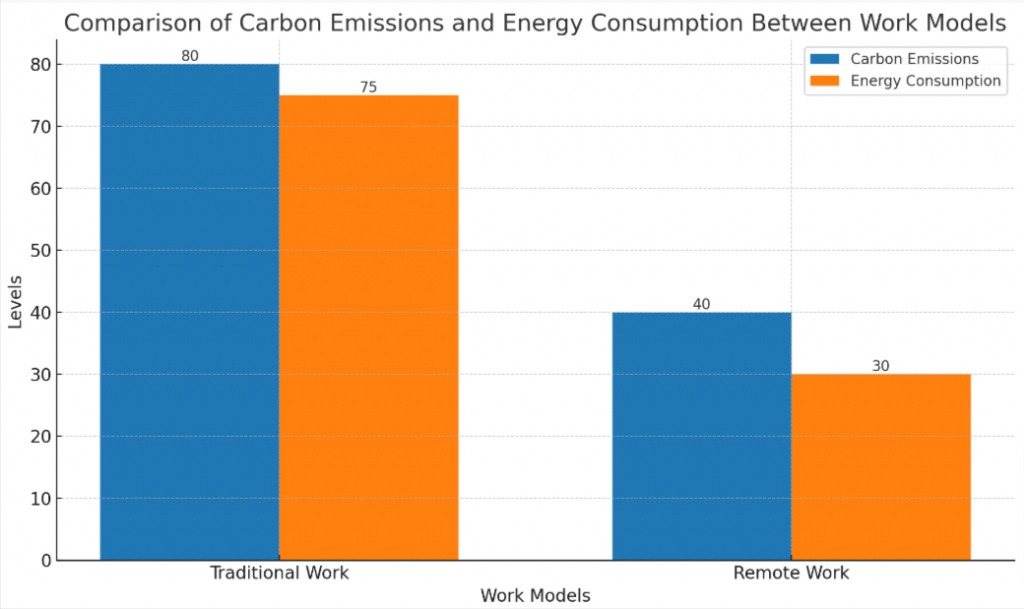Embracing Eco-Friendly Practices: The Future of Sustainability in Remote Work
Are you curious how working from home could pick up the mantle of sustainability? Well, during the peak of COVID-19 pandemic, global CO2 emissions dropped by 17% due to increased remote work.
This blog lifts the lid on how we can enhance our WFH practices to maximize this potential for a greener future. Curious yet? Dive in and let’s explore together!
Key Takeaways
- Remote work reduces transportation emissions and office energy consumption, leading to lower carbon emissions and improved air quality.
- The shift to hybrid workplace models combines remote work with in – person office time, offering greater flexibility while reducing commuting times and energy use in traditional offices.
- Cultivating a sustainability culture is crucial for promoting environmentally responsible behaviors in remote work, including setting goals, providing training, recognizing green behavior, fostering collaboration, and integrating sustainability into policies.
The Environmental Impacts of Traditional Workplaces
Traditional workplaces have significant environmental impacts, from the emissions generated by employee commuting to the energy consumption of office spaces.
Commuting
Daily commuting to and from the workplace significantly contributes to air pollution and greenhouse gas emissions. According to data, people who switched to working from home during the pandemic saw a significant reduction in their vehicle miles traveled.
Reducing the number of commuters on roads not only decreases carbon dioxide emissions but also other harmful pollutants such as nitrous oxide. However, a downside has been observed where individuals are using their vehicles for increased non-work related travel or making more short trips, counteracting some environmental benefits.
Therefore, finding effective sustainability strategies that maintain reduced commuting while dissuading additional non-essential trips is critical for long-term environmental impact, highlighting just one aspect of how traditional commute affects our planet’s health considerably.
Office Energy Consumption
Traditional workplaces are major consumers of energy. Lights, heating and cooling systems, office machines and computer networks collectively contribute to significant energy consumption.
These elements continuously consume power throughout the day, leading to substantial carbon dioxide emissions. Businesses operating from commercial buildings heighten their environmental impact due to heavy reliance on fossil fuels for electricity generation.
An increase in remote work practices can effectively curb such levels of energy utilization in offices, providing a greener alternative for businesses aiming towards sustainable operations.
The Environmental Benefits of Remote Work
Remote work offers a range of environmental benefits, including reduced transportation emissions, decreased office energy use, and lower levels of urban air pollution.
Reduced Transportation Emissions
Switching to remote work greatly decreases transportation emissions. Daily commutes contribute significantly to greenhouse gas emissions, with cars being the main culprits. A noticeable downturn in emissions occurred when millions started working from home during the COVID-19 pandemic.
For instance, global CO2 emissions dropped by 17% in April 2020 compared to peak 2019 levels. Despite this victory, as people slowly transition back into offices and daily life returns to normal, emission levels are creeping up again.
However, if businesses continue encouraging remote work or adopt hybrid models where employees only commute a few days per week, we might establish a new norm that keeps transportation-based carbon footprints at bay.
Decreased Office Energy Use
Switching to remote work contributes significantly to decreased office energy use. Traditional offices consume large amounts of electricity for heating, cooling, and powering electronics.
Now imagine an entire building going dark because it’s no longer required as a physical workplace. This leads to a substantial reduction in energy consumption which is a key aspect of sustainability efforts within organizations.
A study found that global CO2 emissions dropped by 17% in April 2020 that can be linked partially to the decrease in energy used in commercial buildings during the height of Covid-19 pandemic when people transitioned largely towards working from home (WFH).
Furthermore, less reliance on traditional office spaces can also lead to lesser demand for new commercial constructions thereby indirectly contributing even further towards environmental sustainability.
Lower Levels of Urban Air Pollution
During the height of the pandemic, remote work resulted in lower levels of urban air pollution. As employees stayed home and reduced their commuting, there was a temporary decrease in harmful emissions like carbon dioxide and nitrous oxide.
This positive impact on air quality was seen in cities all over the world. However, it’s important to note that as people have continued to work remotely, urban air pollution levels are slowly returning to pre-pandemic levels.
The sustainability impact of remote work on urban air pollution depends on employee behaviors such as travel patterns, energy use, technology consumption, and waste management practices.
The Challenges of Sustainability in Remote Work
Remote work poses several challenges in terms of sustainability. One major challenge is the energy footprint of remote technology, as increased usage of laptops, personal computers, and other devices can contribute to higher electricity consumption.
Another challenge is the waste footprint of home offices, including electronic waste from outdated or broken equipment. Both these challenges need to be addressed for remote work to become more environmentally sustainable.
Energy Footprint of Remote Technology
Remote technology, such as laptops and communication devices, plays a crucial role in enabling remote work. However, it also has an energy footprint that deserves attention. Studies have shown mixed results when it comes to the impact of remote work on energy use.
While some research suggests a positive effect due to reduced commuting and office energy consumption, other studies indicate a neutral or even negative impact. It’s important to consider the energy used by remote technology itself, as well as potential rebound effects like increased non-work travel and short trips that can offset any gains in energy savings.
One study found that digital behaviors, including tasks like sending emails, contribute to an individual’s carbon footprint. In fact, a “typical business” user creates around 135kg (298lbs) CO2e per year from email usage alone.
Additionally, the adoption of remote work policies often involves providing employees with laptops or other devices. While this allows for flexible work arrangements, it can also lead to duplication of devices and potentially contribute to e-waste issues.
Waste Footprint of Home Offices
Home offices can contribute to a significant waste footprint, which is an important consideration when it comes to sustainability. With the shift to remote work, employees are generating more waste at home, including paper, packaging materials, and electronic waste.
In fact, during the pandemic, there was a surge in e-waste due to increased reliance on technology for work purposes. This means that organizations and individuals need to prioritize effective waste management strategies to minimize this impact.
By implementing recycling programs and encouraging responsible disposal of electronic devices, we can reduce the environmental impact of our home offices and move towards a more sustainable remote work model.
How Remote Work Is Changing the Future
Remote work is driving the shift to hybrid workplace models and expanding geographic flexibility for workers.
The Shift to Hybrid Workplace Models
The shift to hybrid workplace models is becoming increasingly common as organizations adapt to the changing work landscape. A hybrid model combines remote work with in-person office time, allowing employees to have more flexibility while still maintaining some level of face-to-face interaction.
This shift has been accelerated by the COVID-19 pandemic, which forced many companies to embrace remote work on a large scale and discover its benefits. The increased adoption of hybrid models not only provides employees with greater work-life balance and reduced commuting times but also contributes to a more sustainable future by reducing transportation emissions and decreasing energy use in traditional office spaces.
Expanded Geographic Flexibility for Workers
Remote work has not only provided employees with the flexibility to work from anywhere, but it has also opened up new possibilities for their geographic locations. With the ability to work remotely, workers are no longer limited to living in close proximity to their physical workplaces.
This expanded flexibility means that individuals can choose to live in areas they truly desire, whether it be closer to family and friends or in a more desirable natural environment.
In fact, during the pandemic, many people took advantage of this newfound freedom by relocating away from crowded cities and into quieter rural areas. This shift not only offers personal benefits for workers but also has the potential for positive environmental impacts as fewer people need to commute long distances on a daily basis.
Making Remote Work More Environmentally Sustainable
Implementing supportive policies, cultivating a sustainability culture, and encouraging local action are key ways to make remote work more environmentally sustainable.
Cultivating a Sustainability Culture
Cultivating a sustainability culture is essential for promoting environmentally responsible behaviors in remote work. It involves instilling a sense of responsibility and awareness among employees, encouraging them to take proactive steps towards sustainable practices. Here are some strategies to cultivate a sustainability culture:
- Promote awareness: Educate employees about the environmental impacts of their actions and how their choices can make a difference. Share important facts, such as the temporary reductions in CO2 emissions during remote work due to reduced commuting.
- Set sustainability goals: Establish clear targets for reducing energy consumption, waste production, and carbon emissions. Encourage employees to actively participate in achieving these goals by making conscious choices.
- Provide training: Offer training sessions on sustainable practices, such as energy-efficient technology usage, proper waste management, and reducing paper usage. Equip employees with the necessary knowledge and skills to incorporate sustainability into their daily work routines.
- Recognize and reward green behavior: Implement recognition programs or incentives for employees who consistently demonstrate sustainable practices in their work. This helps create a positive reinforcement system that motivates others to follow suit.
- Foster collaboration: Encourage open discussions and idea-sharing among employees regarding sustainability initiatives. Create platforms for employees to collaborate on innovative ideas for reducing environmental impact.
- Lead by example: Leadership should prioritize sustainability and integrate it into the company’s values and decision-making processes. Executives should model environmentally responsible behavior themselves to inspire others within the organization.
- Integrate sustainability into policies: Incorporate sustainability considerations into company policies, such as remote work guidelines and procurement practices. Make sure policies support environmentally friendly choices and hold individuals accountable for their actions.
- Measure progress: Regularly assess and measure the impact of sustainability initiatives within the organization. Use data from studies on remote work’s environmental effects to track progress towards reducing energy use and carbon emissions.
- Encourage employee involvement: Involve employees in decision-making processes related to sustainability. Seek their input and involve them in shaping the company’s sustainability strategies.
- Create a supportive work environment: Foster a culture where employees feel empowered to make sustainable choices. Provide resources, tools, and support for implementing sustainable practices.
Implementing Supportive Policies
Implementing supportive policies is crucial in making remote work more environmentally sustainable. These policies can help guide and encourage employees to make pro-environmental actions while working remotely. Here are some key policies that organizations can implement:
- Encouraging the use of renewable energy: Organizations can provide incentives or subsidies for employees to switch to renewable energy sources for their home offices, such as solar panels or wind turbines. This can significantly reduce the carbon footprint associated with remote work.
- Promoting active travel for essential trips: Organizations can encourage employees to choose low-carbon transportation options like walking, cycling, or using public transportation for essential meetings or errands outside of their homes. This reduces reliance on cars and helps decrease greenhouse gas emissions.
- Implementing a meeting policy: Organizations can establish guidelines on when in-person meetings are necessary and when virtual meetings are preferred. By reducing unnecessary travel, organizations can minimize carbon emissions associated with employee travel.
- Supporting recycling and waste management: Organizations can provide resources and guidelines to help employees properly dispose of waste generated from their home offices, especially electronic waste (e-waste). This promotes responsible waste management practices and reduces environmental harm.
- Creating a sustainability culture: By integrating sustainability into the organizational culture, companies can foster an environment where employees are encouraged to adopt green behaviors both at work and in their personal lives. This includes raising awareness about the environmental impact of remote work and providing resources for sustainable living.
- Offering flexible scheduling options: Organizations can implement flexible scheduling policies that allow employees to choose their working hours based on their personal circumstances. This not only improves work-life balance but also reduces peak-hour commuting, leading to reduced traffic congestion and lower carbon emissions.

Encouraging Local Action
Encouraging local action is crucial for making remote work more environmentally sustainable. Here are some ways to encourage local action:
- Promote sustainable transportation options, such as biking or walking, for employees who live close to their workplace.
- Implement energy – efficient practices in local offices, such as using LED lighting and smart thermostats to reduce energy consumption.
- Support local initiatives that focus on renewable energy sources, like solar or wind power, to offset the carbon footprint of remote work.
- Collaborate with local communities to develop recycling programs and reduce waste from home offices.
- Offer incentives for employees to support local businesses and purchase eco – friendly products in their communities.
- Educate employees about the environmental impact of their daily choices and provide resources for pro-environmental actions at a local level.
Conclusion
Remote work has emerged as a powerful tool for promoting sustainability. By reducing commuting and office energy consumption, remote work contributes to lower carbon emissions and improved air quality.
However, challenges persist in managing the energy and waste footprints associated with remote technology and home offices. As we move into the future, it is crucial for organizations to cultivate a sustainability culture, implement supportive policies, and encourage local action to make remote work more environmentally sustainable.

